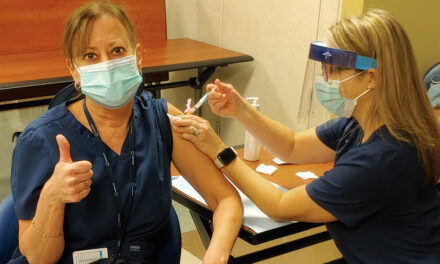Twelve years ago, at the age of 55, Linda Martin, owner of Flutter Boutique in Pennington, was commuting between Ewing, N.J., and Herald Square in New York City where she ran the human resources department for Macy’s stores. Her normally easy walk from Penn Station to the department store seemed to tax her more than it should have. “Some mornings, that walk seemed endless because I would have to stop once or twice and put down my tote bag,” she recalls. “It was unusual because I generally walked very fast, very deliberately.” More suspicious was a burning sensation in the back of her throat when she walked—she likens the sensation to the feeling of running outside and breathing in cold air.
What Martin didn’t know was that these symptoms were warning signs of an impending heart attack. Like many women, her symptoms were atypical, and at age 55, with no real risk factors, Martin wasn’t the poster child for cardiac disease. But Martin trusted her instincts that something was wrong with her body—even when her physicians downplayed her symptoms—sought medical care, and, as a result, is alive today to share her story with other women. Now 67 and the owner of Pennington’s Flutter Boutique, she stresses the importance of being your own healthcare advocate.
“No one knows your body better than you do,” she says. “If you feel something is wrong, chances are there is something wrong. You can’t take no for an answer.”
What Linda didn’t know was that these symptoms were warning signs of an impending heart attack. Like many women, her symptoms were atypical, and at age 55, with no obvious risk factors, Linda wasn’t the poster child for cardiac disease. But she trusted her instincts that something was wrong with her body—even when her physicians downplayed her symptoms—sought medical care, and, as a result, is alive today to share her story with other women. Now 67 and the owner of Pennington’s Flutter Boutique, Linda stresses the importance of being your own healthcare advocate.
“No one knows your body better than you do,” she says. “If you feel something is wrong, chances are there is something wrong. You can’t take no for an answer.”
Understanding the Atypical
For years, heart attacks had a bit of an image problem. Hollywood portrayed cardiac arrest as a male problem that started with a pain shooting down the left arm followed by a clutching of the chest and ending with the patient collapsing on the floor. Unsurprisingly, Hollywood didn’t get it exactly right.
For starters, heart disease affects both men and women. It’s not only the leading cause of death in women, it kills more women than men, according to the American Heart Association’s Go Red for Women. While both sexes typically present with classic heart-attack symptoms, such as crushing chest and arm pain, women are more likely to have atypical symptoms, says Kristopher Young, DO, a cardiologist with Capital Health.
Atypical symptoms can include nausea, heartburn, fatigue, lightheadedness, and/or pain in the back, neck, jaw, or stomach. According to the Women’s Heart Foundation, 71 percent of women experience early-warning signs of a heart attack with sudden onset of extreme weakness that’s often likened to the flu—and sometimes have no chest pain at all. “If you are normally a get-up-and-go person and can’t do things like you did a few months ago, that is a warning you need to be evaluated,” Dr. Young says. “The key is not to ignore a new symptom.”
These atypical symptoms can also confuse physicians—something that Linda experienced on three separate occasions when she had her first cardiac episode. Concerned about her strange symptoms, she went to her primary care physician, who diagnosed her with acid reflux and prescribed Nexium. Convinced it was heart- and not GI-related, Linda insisted on a referral to a cardiologist.
The Saturday before her cardiology appointment, Linda woke in the middle of the night with a pounding heart after taking her migraine medicine. Fearing it was a heart attack, her husband, John, rushed her to the emergency room. When her EKG and chest x-rays came back normal, the physician on duty attributed Linda’s pounding heart to anxiety and stress, and recommended yoga and meditation. “[The doctor] said, ‘I doubt it’s your heart,’” Linda remembers. “She said, ‘You’re not old enough to have heart disease.’”
When she met with the cardiologist, he echoed the ER doctor’s sentiment—“He told me if I had heart disease, I was his youngest patient ever with the condition,” says Linda—and recommended an exercise stress test. Unsatisfied, Linda demanded the more intensive “nuclear” stress test. “I told him I didn’t think I could walk on a treadmill,” she says. “I couldn’t walk from the train station across the block to my office without stopping twice.” The following day after reading the results, Linda’s cardiologist called and told her to get to the hospital right away. Her left anterior descending artery—aka “the widow-maker”—was 99.9 percent blocked. Linda was on the verge of a massive heart attack. She remembers the doctor telling her husband after the procedure that she had been hanging by a thread and would have had a massive heart attack and could have died in another day or two.
“Bottom line is, I went to three doctors. All had good reputations. All with good intentions,” Linda says. “One said reflux, one said anxiety, and the other said there was no need for a stress test. Had I not persisted and then insisted on seeing a cardiologist and having a nuclear stress test, I wouldn’t be here today.”
Be Your Best Advocate
According to the American Heart Association, men are more likely than women to survive their first heart attack. Part of the problem, studies have shown, is that women are more likely to delay going to the emergency department if they think they are having a heart attack. “There are two main factors for this,” Dr. Young explains. “First, when having atypical symptoms, it is difficult to think there is a major problem. Symptoms can be mild or moderate in intensity. The second reason is that women are more likely to put off their own care to attend to other responsibilities.”
Linda’s story underscores the importance of recognizing the atypical symptoms women can experience with heart disease and heart attacks. It also demonstrates the value of advocating for yourself—a position that can be challenging for many women—especially when your body is telling you something isn’t right.
“I tell patients, ‘You are your own best advocate,’” says Dr. Young. “It is common for heartburn or anxiety to be blamed for presenting symptoms. If you are told your symptoms are due to one of these etiologies but you have no prior history, I would share that with your physician. Our job is to do our best to assure your symptoms are not due to a potentially fatal problem.” He recommends that patients should explain all of their concerns to a doctor and avoid up- or downplaying symptoms.
In June 2016, Linda experienced a second heart attack—and once again, she encountered a physician unconvinced that it was her heart. During a weekend getaway to Stone Harbor to celebrate her birthday, Linda began to experience heaviness while carrying her bag when she walked, fatigue, and a general sense that something wasn’t right. When she began experiencing that burning sensation in the back of her throat, she knew right away it was her heart and headed straight for the hospital. She described her symptoms to the ER doctor, who asked if she was experiencing chest pain or pain in her left arm. When she said no, he replied, “It’s not a heart attack.” A blood test proved him wrong.
When the on-call cardiologist met with Linda, he explained that she would need a stent to open the blocked artery, but since it was Saturday evening, they’d have to wait until Monday morning. When the doctor left, Linda felt unsettled by the conversation and asked for the doctor. “I said, ‘I’m not going to wait until Monday,’” she recalls. “They put me on a nitro drip overnight and they did the procedure the next morning. To even suggest someone wait another day was mind-boggling to me. It was 99.5 percent blocked. This was a serious blockage. I left that cardiology group.”
Prevention 101
The good news about heart disease is that certain lifestyle changes can dramatically reduce your risks—even if you have a family history. “The majority of patients with heart disease have risk factors that can be eliminated with a healthy lifestyle,” Dr. Young says. “A large study showed that 90 percent of risk factors for heart attack are modifiable. The goal is to stay active, not smoke, and maintain a healthy weight.”
Moreover, it’s important to know your numbers—cholesterol, blood pressure, and blood sugar—which you can keep track of with an annual physical. “If you develop high blood pressure, high cholesterol, or diabetes, lifestyle modification is still the first recommendation,” Dr. Young says. “Medications are sometimes necessary when appropriate changes in lifestyle are not made or are just not enough.
“We can’t change our gender or family history, and of course we can’t stop aging,” Dr. Young continues. “However, the other risk factors are very heavily weighted in developing a heart attack and are very modifiable. Your primary care physician will work with you to help achieve optimal health to reduce future risk.”
Also important is stress management. “There is clear evidence that depression, anxiety, and stress play a key role in developing a heart attack,” Dr. Young says. “It is essential to do what you can to limit these factors.” Chronic stress can have a negative impact on your health, including raising your heart rate and blood pressure, contributing to plaque buildup in the arteries, and weakening the immune system. Many people also deal with stress with unhealthy behaviors like smoking, lack of exercise, drinking, and overeating.
Linda, a self-acknowledged Type-A personality, points to stress as the culprit for her heart attacks. When she had her first episode, her blood pressure and cholesterol had been normal and she had no real family history. At the same time, she was under increased stress at her already high-pressure job at Macy’s. Linda’s long days and long commute made exercising difficult, she was caring for two elderly parents, and eating healthy wasn’t always a priority. Simply put, like so many women, she was taking care of everyone and everything else before taking care of herself.
After her first heart attack, she made it a priority to take better care of herself, working with a trainer and focusing on healthy eating habits. Following her second heart attack, her new cardiologist suggested Linda look into stress management. “I’ve always had a problem saying no,” she admits. “Now, I am selective about what I do. I know that my heart disease is directly related to the stress in my life.”
Fulfilling her lifelong dream of running a clothing boutique, Linda uses her role in the Pennington community to educate women about the signs and dangers of heart disease. “My whole idea was to have a store for women to feel comfortable shopping, be able to browse, just enjoy the experience,” she explains. “The formula was affordable fashion, great quality, and great service, and also to use the store as a platform to give back to the community and help women.
“I try to talk to women. I do ads, send emails,” Linda continues “I try to get everyone thinking about it. We all talk about our heart and how important it is. The bottom line is to love your heart—you only get one.”





